| کد مقاله | کد نشریه | سال انتشار | مقاله انگلیسی | نسخه تمام متن |
|---|---|---|---|---|
| 4557814 | 1329899 | 2013 | 8 صفحه PDF | دانلود رایگان |

• Quantitative genetic techniques used to analyze tolerance to Cry1Ab in O. nubilalis.
• Upper limit of heritability for tolerance was 0.82–0.90 for field-derived populations.
• Lande’s formula estimated more than two segregating factors influencing tolerance.
• Contribution of cadherin to tolerance assayed with EPIC marker.
Tolerance to Bacillus thuringiensis Cry1Ab toxin in Spanish Ostrinia nubilalis populations was analyzed by quantitative genetic techniques, using isolines established from field-derived insects. F1 offspring was tested for susceptibility to trypsin activated Cry1Ab using a concentration that caused a mean larval mortality of 87% (±17% SD). The progeny of the most tolerant isolines (that had shown mortalities lower than 60%) was crossed to obtain the F2 generation that was exposed to the same Cry1Ab concentration. A clear reduction in mortality (62 ± 17% SD) was observed. The upper limit for heritability was estimated to range between 0.82 and 0.90, suggesting that a high part of phenotypic variation in tolerance to Cry1Ab was attributable to genetic differences. An estimate of the minimum number of segregating factors indicated that the loci involved in tolerance to Cry1Ab were at least two. The role of the cadherin gene, which is a B. thuringiensis resistance gene in Lepidoptera, was assessed in the most tolerant isolines by using an EPIC-PCR marker specifically developed for this study. Association between cadherin and tolerance was obtained in one tolerant isoline; however it could be not confirmed by segregation analysis in the F2 progeny because F2 offspring was not viable. Our results indicate that the tolerance trait is common in Spanish field populations. Quantitative genetic techniques may be helpful for estimating the influence of genetic factors to Cry1Ab tolerance in O. nubilalis.
Figure optionsDownload as PowerPoint slide
Journal: Journal of Invertebrate Pathology - Volume 113, Issue 3, July 2013, Pages 220–227